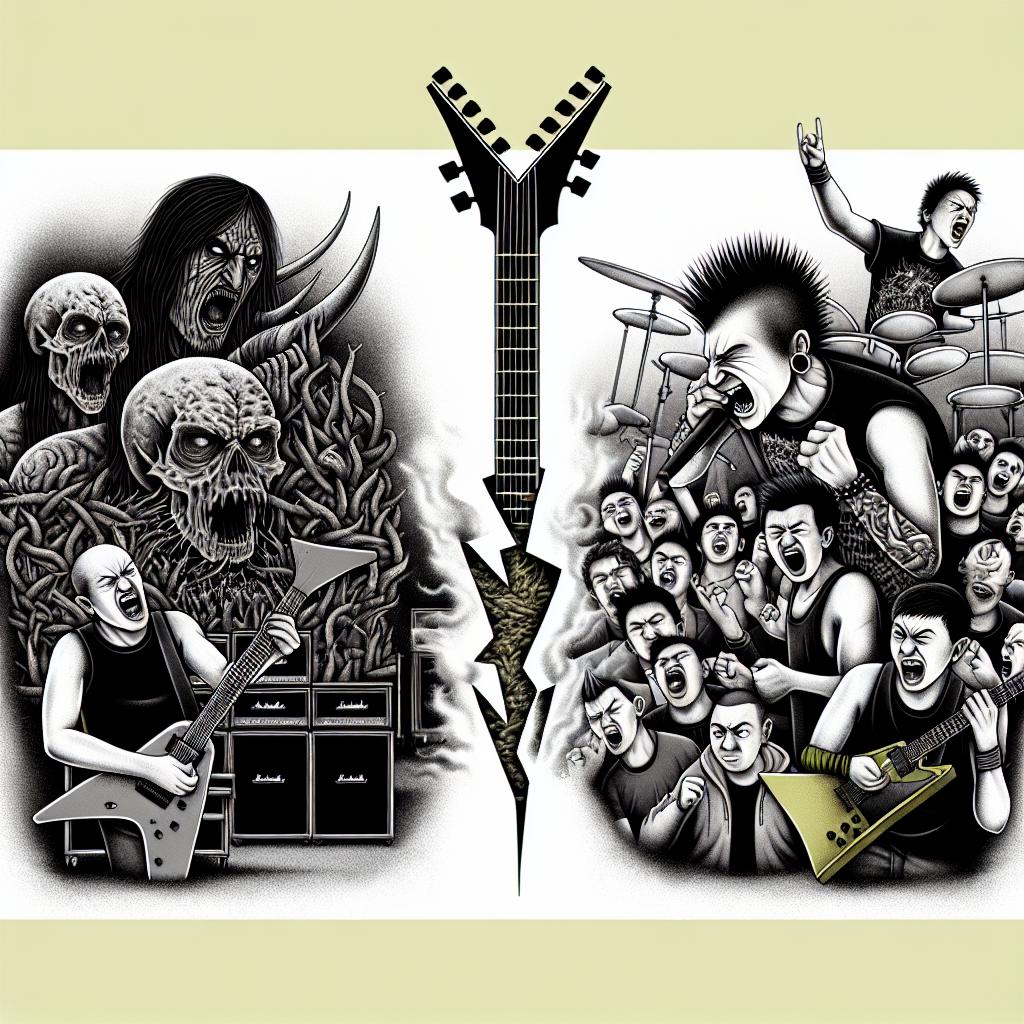The Growth of Metalcore: Blending Metal and Hardcore

The Origins of Metalcore
Metalcore, a fusion genre combining elements of extreme metal and hardcore punk, finds its roots in the late 1980s and early 1990s. During this time, bands began to explore new sonic territories by blending the aggressive riffs and breakdowns typically associated with metal music with the high-energy paradigm and antiauthoritarian ethos of punk rock. This crossover was not merely about musical amalgamation but also about creating an aural experience that resonated with a broad audience. Key bands such as Converge, Earth Crisis, and Integrity are often credited as pioneers of this new genre. By deftly mixing these genre elements, they laid a solid foundation for the soundscape and aesthetic that would come to define metalcore.
Metalcore represents a reaction against the increasingly polished nature of mainstream music during the time of its inception. Bands in this genre sought to return music to its roots in raw expression, channeling both the technical precision of metal and the emotive power of hardcore punk. Thus, metalcore functions not only as a musical genre but as a statement against the dilution of musical authenticity.
The Rise of Prominent Metalcore Bands
The early 2000s marked a significant period of growth for metalcore, as the genre began to captivate a larger commercial audience. This was largely due to the pioneering efforts of bands like Killswitch Engage, As I Lay Dying, and Unearth. These bands managed to reach wider audiences, thanks to their adept blending of melodic motifs with more aggressive instrumentals and vox. Notably, while maintaining the aggressive bite and energy characteristic of metalcore, these bands infused their music with an accessibility that broadened the appeal of the genre beyond its initial niche following.
This new commercial viability of metalcore bands can be attributed to their innovative soundscapes and the dynamic energy they brought to live performances, making them a favorite both on stage and in studio recordings. The rise of these bands significantly influenced subsequent generations of metalcore music, guiding the genre’s evolution and bringing it more into mainstream consciousness.
Characteristics of Metalcore
Various defining characteristics are essential for understanding metalcore’s unique appeal and identity. Central to this is the incorporation of breakdowns, a musical technique borrowed from hardcore punk. Breakdowns involve intentionally slowing the tempo to create powerful, rhythmic sections that often act as focal points during live performances. This creates an intense dynamic and engages audiences with the physicality of the sonic experience.
Other important features include the use of screamed vocals, where vocalists employ extreme vocal techniques to amplify the music’s intensity. Screaming has become a signature trait of metalcore, serving to heighten the emotive payload of songs. The juxtaposition of melodic guitar riffs with heavier, distorted riffs is another trademark of the genre. This duality allows metalcore songs to navigate an emotional breadth, balancing moments of melodic clarity with passages of raw, aggressive energy.
Themes in metalcore music frequently address personal and social issues, inserting a layer of depth and relatability. By using music as a platform to shed light on issues of personal struggle, societal discontent, and existential concerns, metalcore resonates with audiences who find solace or understanding in shared experiences.
Evolution and Hybridization
The continual evolution and hybridization that characterizes metalcore enable it to remain a dynamic and adaptable genre. This has led to the emergence of several subgenres. Deathcore stands out as a significant subgenre by merging elements from death metal—characterized by its brutal and technical intensity— with the foundational aspects of metalcore.
Another emergent subgenre is djent, which incorporates polyrhythmic structures and progressive elements into the metalcore paradigm. Bands like Architects and Bring Me the Horizon have been instrumental in this transformative progression. These bands have integrated electronic components, more sophisticated production techniques, and cleaner vocal techniques into the traditional metalcore setup, significantly broadening the genre’s appeal.
These evolutionary steps reflect the genre’s capacity to absorb diverse musical and thematic influences, allowing it to stay contemporary while maintaining a core identity. The introduction of these new elements often leads to an enriched sound, facilitating both sonic and conceptual expansion.
The Global Impact of Metalcore
Over the years, metalcore has not only persisted but has achieved recognition on an international scale. Bands originating from across the globe, including those from Germany, Japan, and Australia, have contributed to the evolution and proliferation of metalcore. This influx of global influences has enriched the genre’s diversity, leading to a cross-pollination of musical ideas that propels metalcore to new creative heights.
Prominent festivals dedicated to metal and punk genres frequently feature metalcore bands, drawing large and diverse audiences and fostering a vibrant sense of community around the genre. This global community has facilitated a fertile environment for metalcore to grow and adapt, cementing its position in the broader landscape of contemporary music.
The ability of metalcore to evolve, alongside its openness to incorporating various stylistic influences, ensures its continued relevance. As the genre moves forward, its intrinsic flexibility and dynamic nature will likely continue to resonate with new generations of listeners.
For further exploration of metalcore and its various facets, including its history and ongoing developments, readers are encouraged to consult a variety of music platforms and publications which frequently update their discussions and analyses on the subject.